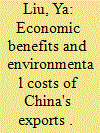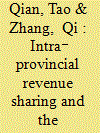|
|
|
Sort Order |
|
|
|
Items / Page
|
|
|
|
|
|
|
| Srl | Item |
| 1 |
ID:
160858


|
|
|
|
|
| Summary/Abstract |
Previous studies have investigated whether Chinese exports have crowded out those from other countries. However, what has yet to be considered is the evidence based on different quality varieties. Using the most detailed Harmonized System 9‐digit product‐level data, the present paper provides evidence of crowding‐out and crowded‐out effects across different product quality segments and across manufacturing sectors by quality segments. The empirical evidence presented in this paper shows that the crowding‐out effects of Chinese exports have been greatest at the lower end of the quality spectrum but less significant at the higher quality spectrum. Moreover, since 2007, China's own exports of lower quality manufactured goods have been increasingly crowded out. The key policy implication is that China's export path is in line with that taken by other Asian economies in previous decades; the crowded‐out effect could achieve win–win outcomes for countries involved; and lower income countries would do well to be open to receive those relocated low value‐added industries from China. However, the relocation policy in China is best implemented gradually as climbing up the product quality ladder takes time.
|
|
|
|
|
|
|
|
|
|
|
|
|
|
|
|
| 2 |
ID:
160861


|
|
|
|
|
| Summary/Abstract |
With sluggish external demand and increasing trade protectionism by the USA and the European Union, China is facing severe challenges in implementing its deeper, ongoing reforms. To respond actively to such challenges, the Communist Party of China's 19th National Congress proposed to “promote a new pattern of all‐round opening up.” In particular, the establishment of free trade ports is considered an important means to realize deeper integration with the world economy. This paper discusses the background, the motivation, the possible challenges as well as a feasible path for the successful implementation of free trade ports in China. Based on the international experience, the construction of free trade ports in China requires freer trade in goods, high mobility of talent and free capital flow.
|
|
|
|
|
|
|
|
|
|
|
|
|
|
|
|
| 3 |
ID:
160863


|
|
|
|
|
| Summary/Abstract |
This paper decomposes economic benefits (value‐added) and environmental costs (CO2) of exports according to their sources, and maps the global value network (GVN) and the global emissions network (GEN) for China's exports during 1995–2009 from national, sectoral and national–sectoral perspectives. A comparison is conducted between China and the USA. National GVN and GEN show that shares of value‐added and CO2 emissions from China in its GVN and GEN both decreased first then increased after 2006, while shares from the USA in its GVN and GEN generally decreased. Sectoral GVN and GEN show that among China's exports, “electrical and optical equipment” and “electricity, gas and water supply” were, respectively, the sectors that obtained the most value‐added and emitted the most CO2. National–sectoral GVN and GEN for China exhibited reciprocal and disassortative patterns, and in‐strengths and out‐strengths of GVN and GEN for China's exports were mainly captured by several domestic country–sector pairs.
|
|
|
|
|
|
|
|
|
|
|
|
|
|
|
|
| 4 |
ID:
160860


|
|
|
|
|
| Summary/Abstract |
Since the end of the Bretton Woods era, the world has operated on a de facto system of free‐floating exchange rates, with the US dollar as the dominant international currency. The system, characterized by large pro‐cyclical capital flows and chronic imbalances, is inherently unstable, and has contributed to repeated crises, recessions and geopolitical tensions. One potentially “least‐difficult” line of reform would be to allow the evolution of a multi‐currency system, underpinned by an expanded role for Special Drawing Rights (SDRs). Attempts to promote wider use of the SDR have foundered on the liquidity premium. However, for Chinese corporations and institutions, at present restricted in their capital account activities, the SDR liquidity premium would appear less daunting. The Chinese authorities could provide policy encouragement for the use of SDRs by their institutions. This initiative, supported by China's Special Administrative Region Hong Kong, would kick‐start an international SDR ecosystem, and encourage even broader use of SDRs, to the benefit of international monetary stability.
|
|
|
|
|
|
|
|
|
|
|
|
|
|
|
|
| 5 |
ID:
160859


|
|
|
|
|
| Summary/Abstract |
This study investigates whether the tax‐sharing system has deteriorated the fiscal capacity of subnational governments by analyzing how fiscal revenues are divided between provincial and sub‐provincial governments. Our study of county‐level fiscal data from Zhejiang Province in China during 1994–2007 shows that intra‐provincial revenue‐sharing rules favor county governments in two ways: (i) they improve county governments ‘fiscal autonomy in terms of using their own revenues; and (ii) they enhance county governments ‘fiscal capacity through province‐to‐county general transfers. In addition, we find that intra‐provincial fiscal revenue‐sharing rules and transfers reduce fiscal disparity between counties.
|
|
|
|
|
|
|
|
|
|
|
|
|
|
|
|
| 6 |
ID:
160862


|
|
|
|
|
| Summary/Abstract |
This paper examines total factor efficiency and productivity performance by taking into account local government debt (LGD) in 31 Chinese provincial regions for the period 2000–2013. The results show that neglecting LGD may overstate economic performance in Chinese provinces. The eastern region shows better performance in single factor efficiency and total factor efficiency than the non‐eastern regions. The western region shows the worst total factor performance. The north‐eastern region is the only region that has experienced a decline in total factor performance. The state‐dominated, investment‐driven development model may help technological progress across Chinese regions but could lead to significant factor misallocation. We argue that biases towards more state‐dominated investment and land supply in less productive western, central and north‐eastern regions, at the expense of investment and land supply in more productive eastern regions, have contributed to the recent slowdown in economic growth in China. Therefore, further market‐oriented reforms in factor markets should be considered in the future.
|
|
|
|
|
|
|
|
|
|
|
|
|
|
|
|
|
|
|
|
|